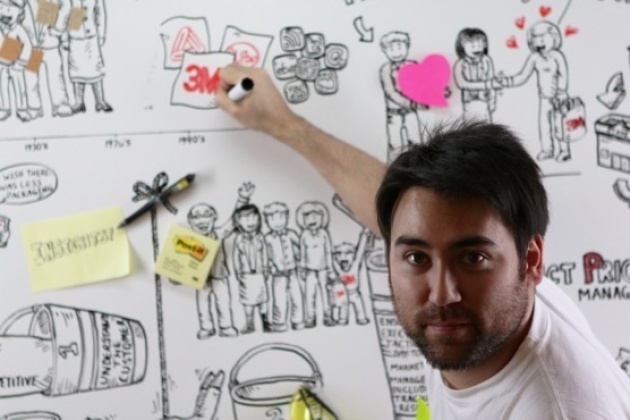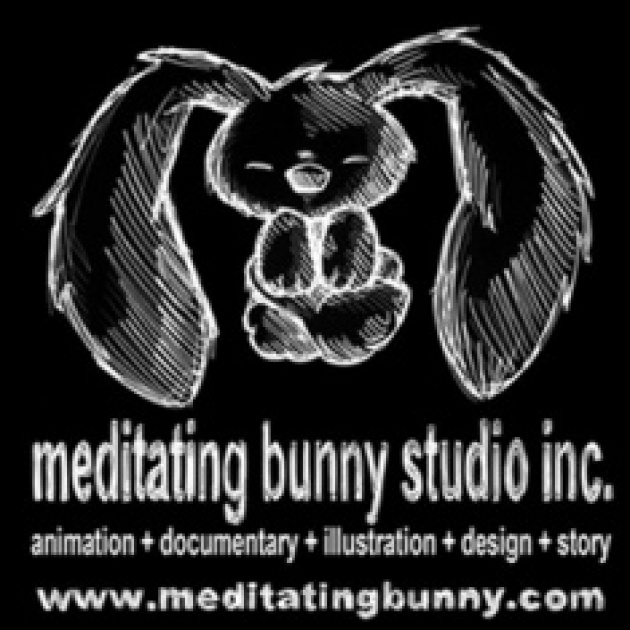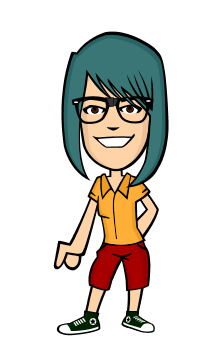
"Animation is the illusion of life and I really believe that animation would be a great tool to teach kids in Afghanistan to be creative, self-reflect, express their ideas, and exercise their imaginations."
Jeff Chiba Stearns is an Emmy® nominated and Webby award winning animation and documentary filmmaker. Born in Kelowna, BC, of Japanese and European heritage, he graduated from the Emily Carr University of Art and Design with a degree in Film Animation in 2001.
FA: What are some of the recurring themes you explore in your films?
JC: I really enjoy exploring themes of personal narrative, identity, philosophy, existentialism, and self-reflection in my films. I especially have a focus on themes of multiethnic identity in my work since my own Canadian background and heritage is blended being part Japanese and European descent. I explore these themes using various mediums such as animation and documentary.
FA: Can you please tell us about Meditating Bunny Studio Inc and the philosophy behind it?
JC: I feel it is very important for every filmmaker to have a filmmaking philosophy to help inspire the types of films I want to make. My philosophy is to create art, films, and media aimed at both children and adults that combine different philosophical and social elements together to create humorous, entertaining, and inspiring stories. I want to produce engaging stories and films that a family can watch together which in turn creates a safe environment to encourage dialogue and discussion between parents and their children.
I named my company, Meditating Bunny Studio Inc. because in 2001 I created a film entitled, The Horror of Kindergarten. In the opening sequence of the film, the main character, Conrad, is sitting in the position of a meditating bunny. The film is loosely inspired by Joseph Conrad's novella The Heart of Darkness and in the beginning of that book, the main character Marlow is sitting in the position of a meditating Buddha. So because my story in The Horror of Kindergarten is about experiencing the first day of kindergarten, I drew my character in a meditating bunny position at the start of his journey. I thought it was cute to pay homage to that line in the book as a direct parallel in my animation.

As well, I like the name Meditating Bunny Studio Inc. because it encompasses my filmmaking philosophy to create films with a philosophical angle for kids. As well, I coined the term 'animation meditation' after creating my 2007 animated film, Yellow Sticky Notes, because I truly feel that animation is meditative process and takes great concentration. When I animate my sticky note films, I put myself into a meditative state in order to create a stream of consciousness of animation through my drawings.
FA: Generally, approximately how many women do you work with on your productions (cast and crew)? Can you tell us about the dynamics of working with women and whether it's different from working with male co-workers?
JC: Creating animation is a very solitary art form since I’m unusually by myself for hours and days on end. Although, I do have a small team that I work once the animation is finished and most of the people on my team are women. My producer, Ruth Vincent, has produced many of my films since 2005. She is responsible for much of my success and has mentored me as a producer. Her daughter, Genevieve Vincent, has scored four of my last films including my first feature-length documentary One Big Hapa Family. Artistically Genevieve and I are very in tune with each other’s creative vision and this is a true collaboration between artists. I love the sensibility that Genevieve brings to the sound and mood of my films with her music. She really understands the feeling and tone of my films and her music really accents my visuals. It's a great partnership in creativity to blend image and sound as one. Because creating animation is a very solitary medium, the only other creative roles are in sound design and music. Thus, I work very closely with Genevieve and her music compositions compliment my work perfectly. I have a great working relationship with Genevieve and in all honesty, I'm not sure that a male composer would truly be able to capture the subtleties, nuances and softness found in my animation.
As well, in my latest animated film, Yellow Sticky Notes | Canadian Anijam, I brought together 15 of Canada’s most award-winning and celebrated independent animators to create a collaborative animated film. I made sure that out of the 15 animators chosen to participate, half of them were women. It was very important to me to have this balance between men and women because I wanted to represent equality in the animation industry and it was important that the film reflected that. The film features animation from some of Canada’s most extraordinary and talented women animators and I’m really proud of that.
FA: How can women be empowered through fine arts, especially a medium like animation?
JC: Definitely! I believe everyone young and old, male and female, tall or short can be empowered though the arts and especially animation. Art and animation are creative outlets for expression and bringing ideas to life. I really believe we all need an outlet for expression in our lives to enrich our imaginations and express our inner self. For women, I believe animation is a great way to express their views, thoughts, and opinions though a visual medium that has the power to connect with a wide audience.
I am currently setting up a Yellow Sticky Note Foundation from proceeds created by the new sticky notes film to teach kids and youth around the world how to self-reflect and express themselves though classical animation created on sticky notes. Much like the Yellow Sticky Notes films I make, I want others to experience the joys of animation. Over the years, I have taught many people of all ages how to use animation meditation to tell their stories and express their emotions through the art form of animation.
FA: Can your work be used as a source of inspiration for filmmakers in particular those who make animation in Afghanistan, Central and south Asia?
JC: Yes, I definitely believe that animation and my work has the power to inspire, educate and entertain people around the world, especially through platforms like the internet which make my work globally accessible to people everywhere and anywhere. Animation is a universal language. Many of us grew up watching animation and cartoons so it is a very familiar medium to us. Although, many people do not understand how animation is created. It is a very misunderstood art form. Therefore, I love to teach others the art and magic of animation. I believe that animation is not that heard to learn and you don’t need to know how to draw to make animation.
Having my films online definitely makes them accessible to millions of people around the world. Every day, I get multiple emails and message from kids and teenagers asking me how to become an animator or asking me for animation tips. As a person who creates media meant to inspire, I love these interactions. This is why I created 'how to' videos online to teach students how to animate on sticky notes.
As well, I've taught animation workshops around the world on how to create low-tech animation without any fancy equipment. As well, I've had many adults email me too and tell me that they have been inspired to paint again after watching my films. It's also great when young fans send me animated sticky notes and stop motion videos they've created after seeing my work online. Many let me know how they were inspired to create an animation of their own after watching my animations. As a filmmaker, this is one of the reasons why I create films, to inspire others to create their own art. It is definitely a good feeling to know that my films are helping others express their ideas and creativity around the world.
FA: What is it about documentaries that has the ability to empower both the audience and filmmakers involved?
JC: I love documentaries and I think it’s great that many of my animations have been referred to as documentaries because they are autobiographical and capture real life stories and events. Documentaries resonate with people and are relatable because they capture real life and truthful stories about the human condition, history, culture, society, nature, our environment, and the world. When done properly, they are honest representations of the people, places, and events that surround all of us. Documentaries have the power to connect us and bring our little planet closer together by sharing our global stories. I love that anyone in the world can tell a story about where and how they live, offering the viewer a window into their lives. I find this fascinating that we can visually tell our stories through this medium and that there is no right or wrong way to do it.
We all have powerful stories to tell and documentaries are real life accounts of these stories. As well, I love documentaries because they capture a moment in our history, like a series of photographs. I find the medium of documentary a compelling way to share these stories with a global audience and empower people around the world to think critically about the world around them.
FA: What is your idea about developing a filmmaking (in particular animation) curriculum and teaching Afghan kids how to animate? How would this affect the educational system in Afghanistan?
JC: I taught college animation for many years as I was creating films. As well, when I graduated from university with an animation degree, I went into teaching high school animation. I've spent a lot of time conducting many workshops for kids, youth, and adults of all ages around the world. I love passing on the knowledge and techniques of animation and I truly believe animation is a great expression of creativity and imagination.
I strongly believe that imagination is one of our greatest tools because it is from imagination that great ideas are born. I also enjoy creating animations where you don't need fancy equipment to make it. You can make animation using flashlights and a camera by taking a series of long exposures and playing them back. You don't even need paper. It's called Lightning Doodles and it's being taught around the world. It is a great way to create a communal piece of animation because it takes a group of people to create the animation together. It is collaborative and created using expressive movements with light. Creating a Lightning Doodle animation is a great community building exercise.
As well, if you have Post-it Notes, you can make a filp book and with some simple drawings, you can flip the pages to create the animated movement. No camera required. All you need is a pencil and a small pad of Post-it Notes. Or you can use a notebook to draw on or create your own pads of paper to flip. There is magic in seeing drawings come to life. Animation is the illusion of life and I really believe that animation would be a great tool to teach kids in Afghanistan to be creative, self-reflect, express their ideas, and exercise their imaginations. We have to realize that creativity is a very important and integral part of education and it is with the building of creative thoughts and ideas that we create progress and innovation. I strongly believe that animation possess has the ability to encourage imaginative thinking and exercise the creativity within all of us.



